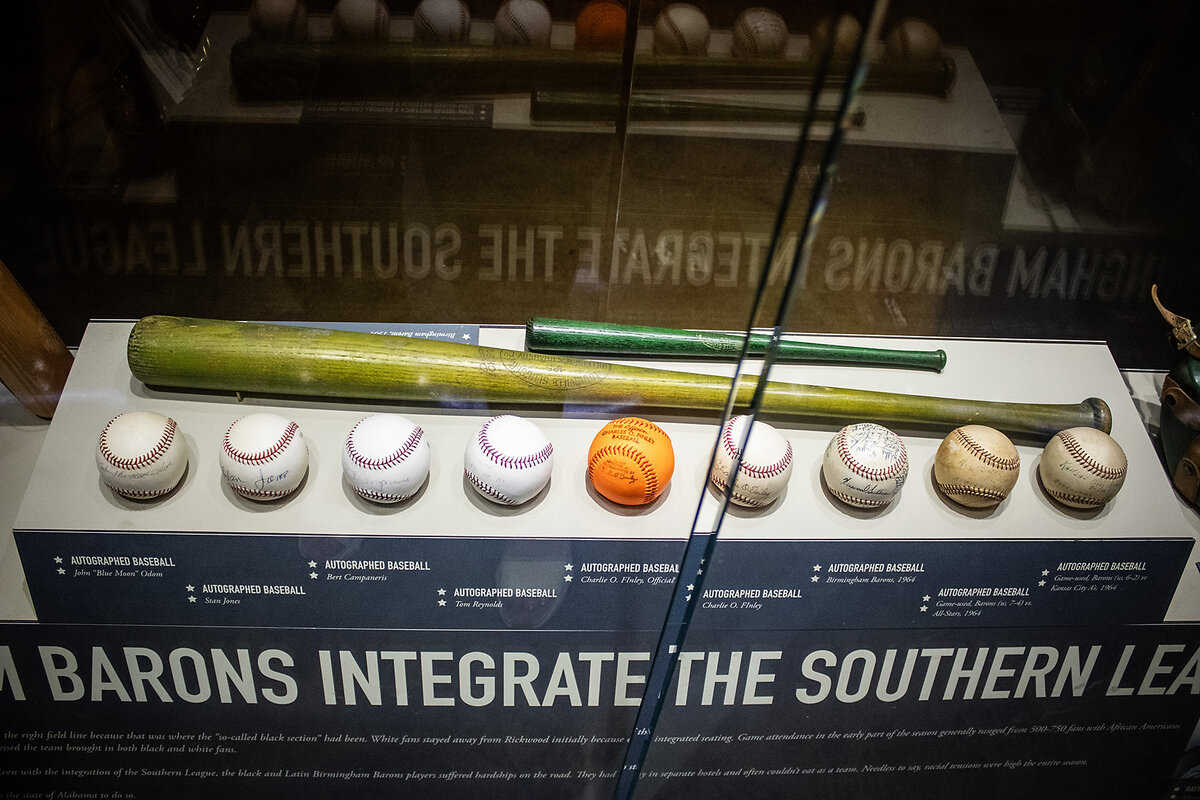Willie Mays, a dugout, and the ‘best’ baseball museum
Loading...
| Birmingham, Ala.
It’s not the first thing you see when you walk into the Negro Southern League Museum, but once it captures your eye, it refuses to let go.
It’s a life-sized poster of Willie Mays, which on a particular Tuesday morning in June, looks like a shrine. It’s lit on the sides and underneath, which give the piece an ethereal feel. Mr. Mays, whether on the baseball field, or in spirit, had that effect on people.
That life-sized poster grabs the attention of Izaiah Quarterman, a 9-year-old from Evans, Georgia, who can’t take his eyes off of the likeness of Mr. Mays. Izaiah heads to a makeshift dugout, where he hangs out with the poise of one of the players highlighted on the walls. His assessment: It’s the “best museum” he’s ever visited.
Why We Wrote This
A story focused onThe Negro Southern League Museum, in Birmingham, Alabama, showcases the perseverance and preservation of Black American baseball – and of its host city.
Birmingham spent a week in June celebrating the Negro Leagues, with everything from a slate of games at historic Rickwood Field to various murals and totems in honor of Mr. Mays, the town’s favorite son. Helping to preserve that legacy, the Negro Southern League Museum stands as one of the game’s great jewels. It brings the Negro Leagues back to life in dramatic fashion, from the images of iconic players, such as Jackie Robinson and Satchel Paige, to the stories of perseverance and preservation of Black American baseball.
Director Anthony Williams reflects the partnership between the city and the museum. He is not a sports guru, and that’s perfect, because his presence represents a balance.
“Baseball historian? Not so much. I’m a historian of the city – a son of the city,” says Mr. Williams, who was born and raised here. “It’s really important, for me in this role, to try to get this education to the rest of Birmingham and try to shine a light on these stories, because I don’t think we got a lot of this growing up.”
On this particular day, he points out a ceiling fixture that honors Mr. Robinson, then tells visitors about the significance of a logo of the Birmingham Black Barons just underneath their feet.
The month before the festivities, Major League Baseball announced it was integrating Negro League statistics into its own, which shook up the record books and was largely celebrated. Some questioned how those numbers could be verified and validated. But the man who collaborated with MLB on the effort pushed back.
“This old adage of there being no artifacts that were left over from the Negro Leagues is just totally wrong,” says Layton Revel, founder of the Center for Negro League Baseball Research, which resides in the museum. “Every artifact you see in this museum, except for two uniforms that I have, one from 1895 and one from 1905, are original. And this represents less than 10% of our collection.”
Integration in baseball – from Mr. Robinson to statistical inclusion of Negro Leaguers – has been celebrated for decades. But there’s one detail that laymen might overlook that the museum does not. There’s a panel, about 10 feet from a section which celebrates integration, with a harrowing header: “The beginning of the decline for Negro League baseball.”
Mr. Williams understands the racial ramifications of integration, not just in sports, but his own city.
“Even with the incorporation of [Negro League] statistics [in MLB], I think there’s going to be some pushback. … A call for keeping things the way they are,” he says. “That does a disservice to the path that was carved. The gentlemen who endured, they had their eyes set on not just baseball, but the American dream.”
The love for Negro League players has manifested itself in a host of ways in Birmingham. The most profound, perhaps, is a pension plan that allows former Negro League players to receive a monthly check from MLB.
“I can remember one of the players called me after he got his pension check. … He said, ‘I just can’t believe that you did this for me.’ And I said, ‘You deserve it,’” Dr. Revel says. “He said, ‘This is the first time I’ve ever been able to go to Walmart, buy my groceries, and pick up my medication.’”
The same day Izaiah from Georgia discovers his new favorite museum, 60-something Shawn Wright, a Birmingham native, arrives at the museum with a treasure. He carries a furled-up colorful advertisement which hovered on his bedroom wall as a kid. It was a promotion for Mr. Mays’ restaurant in Birmingham, which his father had created as a graphic designer for the advertising company Lucky.
“[My dad] put together this collage of images of Willie Mays in a very 1969 style with all the bright colors. I was 6 at the time, but I guess in the next year, Dad had a couple of extra sheets left over from the project, and I showed up from school one day, and they had redone my bedroom,” Mr. Wright says. “I’m not sure if I knew about Willie Mays at the time, but I certainly did after that. He was around me until I moved away from home after college.”
Dr. Revel’s eyes light up when he sees the gift. Mr. Wright had longed to find a home for the pieces that make up the ad.
“[Our family] wanted to give away some of our mementos to people who would appreciate them,” Mr. Wright says. “When I contacted Dr. Revel to see if he wanted these, he was pretty excited. I’m pretty excited.”
The Wright family’s contribution. The continuing efforts to uplift marginalized players. The duality of a civil rights town once derisively named Bombingham, for the violence that happened in its borders. They are all part of the fabric that not only constitutes the museum, but life in the South itself.
“It’s important that people tell their side of the story … the memories of Birmingham and Rickwood Field that aren’t so good,” Mr. Williams, the director, says. “Birmingham is on a comeback, and we’re trying to reclaim these spaces and these ideas that don’t belong to any particular race. They belong to us all, and so we have a part to play in telling these stories and to be present in this era.”
On that Tuesday in June, no one realized it would be the day Mr. Mays would die, at 93. But if Izaiah’s plans are any indication, the future is in good hands. “How long do you want to play baseball,” he is asked.
“‘Til I’m 90.”







